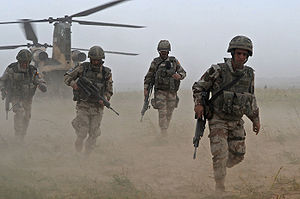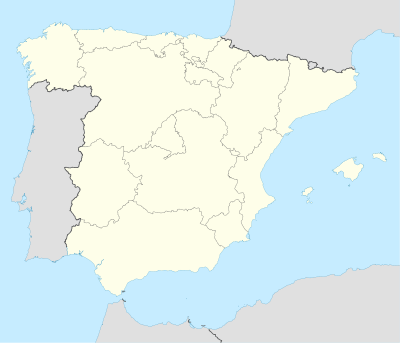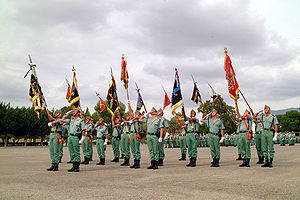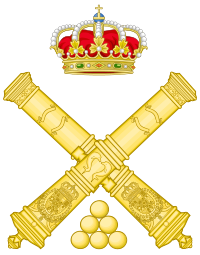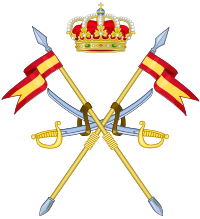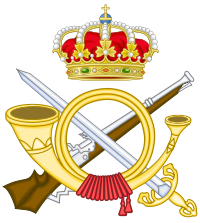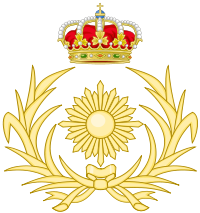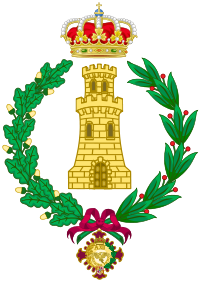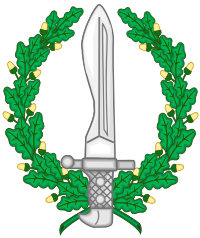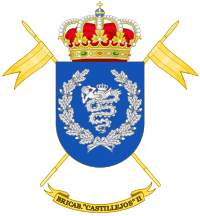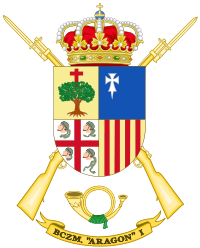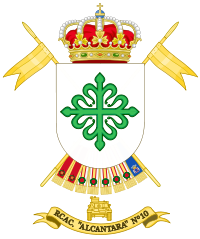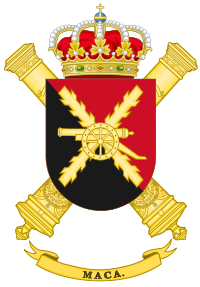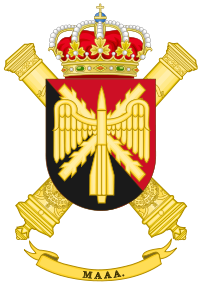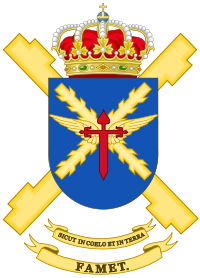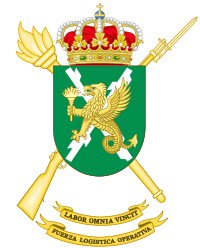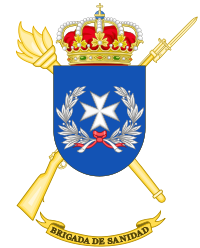- Spanish Army
-
Ejército de Tierra
Spanish Army
Seal of the Spanish ArmyFounded 15th century – present Country Spain Branch Army Size aprox 90,000 personnel (2011) Garrison/HQ Buenavista Palace, Madrid Commanders Commander in Chief and Captian General King Juan Carlos I Chief of Army Staff General Fulgencio Coll Bucher Aircraft flown Attack Tiger Reconnaissance MBB Bo 105 Trainer Colibrí Transport Chinook Cougar The Spanish Army (Spanish: Ejército de Tierra; lit, "Ground Army") is the terrestrial army of the Spanish Armed Forces responsible for land-based military operations. It is one of the oldest active armies - dating back to the 15th century.
Contents
Introduction
The Spanish Army has existed continuously since the reign of King Fernando and Queen Isabel (late 15th century). The oldest and largest of the three services, its mission was the defense of peninsular Spain, the Balearic Islands, the Canary Islands, Melilla, Ceuta and the Spanish islands and rocks off the northern coast of Africa.
The army is completing a major reorganization. It had previously been organized into nine regional operational commands. These were reduced to six commands in conjunction with a revised deployment of forces: Central Command, Southern Command, Levante Command, Eastern Pyrenees Command, Northwestern Command, and Western Pyrenees Command. In addition there were the two military zones of the Canary Islands and the Balearic Islands. Ceuta and Melilla fell within the Southern Command. At the head of each regional and zonal command was an officer of three-star rank. Although his authority had been reduced, the regional commander, who held the title of captain general (Spanish: Capitán General), was still among the most senior officers of the army.
Under its earlier organization, the army was grouped into two basic categories: the Immediate Intervention Forces and the Territorial Operational Defence Forces. In theory, the former, consisting of three divisions and ten brigades, had the missions of defending the Pyrenean and the Gibraltar frontiers and of fulfilling Spain's security commitments abroad. The latter force, consisting of two mountain divisions and fourteen brigades, had the missions of maintaining security in the regional commands and of reinforcing the Civil Guard (Spanish: Guardia Civil) and the police against subversion and terrorism. In reality, most of the Immediate Intervention Forces were not positioned to carry out their ostensible mission of protecting the nation's borders. Many units were stationed near major cities—as a matter of convenience for officers who held part-time jobs—from which they also could be called upon to curb disturbances or unrest.
In a gradual process that had not been fully completed, the division of the army into the Immediate Intervention Forces and the Territorial Operational Defence Forces was being abolished. The brigade had become the fundamental tactical unit. The total number of brigades had been reduced from twenty-four to fifteen by the dismantling of nine territorial defence brigades. Eleven of the brigades had been organized within the existing five divisions; three brigades were to be independent, and one was to be in general reserve.
The best equipped of the five was the First Division, the Brunete Armored Division, with its armored brigade in the Madrid area and its mechanized brigade farther to the southwest near Badajoz. The motorized Second Division, Guzman el Bueno Division, which had acquired a third brigade as a result of the reorganization, was the major defensive force in the south, with full capability for rapid maneuver. The mechanized Third Division, the Maestrazgo Division, under the Levante Command, consisted of two brigades considered to have a moderate degree of mobility. The two mountain divisions, the Fourth Division—or Urgel Division and the Fifth Division—or Navarra Division, each consisting of two mountain brigades, remained in the Pyrenees border area of the north. Two of the four independent brigades were armored cavalry, one was an airborne brigade, and one was a paratroop brigade (in general reserve).
Numerous other changes were introduced as well, including the reorganization of artillery forces not included in the major combat units. This involved the creation of a field artillery command that consisted of a restructured and consolidated former artillery brigade, the creation of a single straits coastal artillery command that replaced two former coastal artillery regiments, and the introduction of an antiaircraft artillery command that was expected to benefit from significant modernizing of its weapons inventory.
The personnel strength of the army, which previously had been maintained at about 280,000, including 170,000 conscripts, had been trimmed to 240,000 by 1987. This was achieved through lower intakes of conscripts and volunteers and through cuts in the table of organization for officers and NCOs. The government's goal was a smaller but more capable army of 195,000 effective by 1991. Outside peninsular Spain, about 19,000 troops were stationed in Ceuta and Melilla. These included, in addition to the Spanish Legion and other specialized units, four regular regiments of North Africans. An additional 5,800 troops were assigned to the Balearic Islands, and 10,000 were in the Canary Islands.
The Spanish Legion, founded in Spanish Morocco in 1920, has always been under the direct command of the chief of the army staff. It has had a reputation as the toughest combat unit in the service, although modelled after the French Foreign Legion, reduced in size in 1987, as a result of successive reorganizations, the legion was scheduled to undergo further cuts to an overall strength of 6,500. It had a higher number of career soldiers than other units, but it was manned mostly by conscripts who had volunteered for the legion. Recruitment of non-Spanish personnel, who had never exceeded 10 percent of the group's manpower, ended in 1986. Foreign legionnaires already in the service were not affected.
The Spanish Legion is grouped into four tercios (sing., tercio), a unit intermediate between a regiment and a brigade, each commanded by a colonel. The first and the second tercios constituted the core of the military garrisons at Melilla and Ceuta (North Africa). Each had been reduced by a motorized battalion, leaving it with a single motorized battalion, a mechanized battalion, an antitank company, and a headquarters company. They were equipped with BMR armored personnel carriers. The Third Tercio, stationed in the Canary Islands, consisted of two motorized battalions and a headquarters company. The Fourth Tercio was being converted from a support role to a combat unit at the legion headquarters in Ronda near Malaga. Although, probably not as "glamorous" outside Spain as their French counterparts, the Spanish legion is as professional and fierce as any other elite force in the world.
The Ministry of Defence was planning the creation of a rapid deployment force composed entirely of volunteers. This force, which would include the Spanish Legion, the Paratroop Brigade, the Airborne Brigade, and Marine units, would be available for use in trouble spots on twelve hours' notice. Lack of adequate air and naval transport would, however, be a limiting factor.
In spite of new procurement programs, introduced in the mid-1980s, weapons and equipment were not in sufficient supply, and they were not up to the standards of other NATO armies. The inventory of medium tanks was made up of nearly 700 American models, as well as about 300 Franco-Spanish AMX-30s manufactured in Spain between 1974 and 1983. Although the military felt that it was essential to adopt a new main battle tank for the 1990s, some considerations led to a postponement of the decision and the upgrading of the AMX-30s with new German-designed diesel engines and transmissions, reactive armor panels, and laser fire-control systems.
Armored troop carriers included about 1,200 M-113s as well as AML-60s and AML-90s and Pizarro infantry fighting vehicles. The Spanish army is in the process of being equipped with more than 1,200 BMRs, a new armored vehicle designed and manufactured in Spain. A variety of towed and self-propelled artillery guns was available, ranging from 105 mm to 203 mm guns and howitzers. The main antitank weapons were recoilless rifles; 88.9 mm rocket launchers; Milan, Cobra, and Dragon missiles; and a small number of TOW (tube-launched, optically tracked, wireguided) and HOT (high subsonic, optically guided, tube-launched) antitank missile systems. A considerable quantity of additional antitank missiles and rocket launchers was on order. The army aircraft inventory included about 280 helicopters, about 40 of which were armed with 20 mm guns or HOT antitank missiles.
Manpower
The army was about 135,000 troops (50,000 officers and 86,000 soldiers) by the end of 2001 when compulsory military service was still in effect. Currently, the Spanish Army is a fully professionalized force (size 86,000). In case of war or state of siege, an additional force of 80,000 Civil Guards comes under the Ministry of Defence command. In 2013 the army will have 130,000 troops, 6000 soldiers less than now, 10,000 less than that desired by the army, and the minimum proposed by the Military Career law 2007.[1]
Ranks
The military ranks of the Spanish Army are as follows below. For a comparison with other NATO ranks see Ranks and Insignia of NATO. Ranks are wore on the cuff, sleeves and shoulders of all Army uniforms, but differ by the type of the uniform being used.
NATO Code OF-10 OF-9 OF-8 OF-7 OF-6 OF-5 OF-4 OF-3 OF-2 OF-1 OF(D) Student Officer  Spain
Spain
(Edit)No Equivalent Capitán general1 General de Ejército Teniente general General de división General de brigada Coronel Teniente coronel Comandante Capitán Teniente Alférez Caballero Alférez Cadete - 1 Retained by His Majesty the King of Spain as his constitutional role.
NATO Code OR-9 OR-8 OR-7 OR-6 OR-5 OR-4 OR-3 OR-2 OR-1  Spain
Spain
(Edit)









Suboficial mayor Subteniente Brigada Sargento primero Sargento Cabo mayor Cabo primero Cabo Soldado de primera Soldado Officer ranks
- Caballero Cadete - Cadet Cavalier
- Caballero Alferez Cadete - Cadet Ensign Cavalier
- Alferez - Ensign
- Teniente - utenant
- Capitan - Captain
- Comandante - Commander/Major
- Teniente Coronel - Lieutenant Colonel
- Coronel - Colonel
- General de Brigada - Brigade General
- General de Division - Divisional General
- Teniente General - Lieutenant General
- General de Ejercito - General of the Army
- Capitan General - Captain General
Ranks of non-commissioned officers and enlisted
- Soldado - Private
- Soldado de Primera - Private First Class
- Cabo - Lance Corporal
- Cabo Primero - Corporal
- Cabo Mayor - Corporal Major/Lance Sergeant
- Sargento - Sergeant
- Sargento Primero - Staff Sergeant
- Brigada - Brigadier/Sergeant First Class
- Subteniente- Sublieutenant
- Suboficial Mayor - Sub-officer Major
1985: situation and equipment
In this year the Spanish Army began a reorganization that included a reduction by 45,000 men. It had, at the time, one armoured division (2 active armoured brigades and one reserve), one mechanized division, one motorized division, and five separate brigades (one each: airborne, armored, air-assault, infantry, heavy artillery). These units, together with some separate regiments, were in the active component of the army (Field Army or FII).
In the Territorial Army (reserve forces, known in Spanish as FDOT) there were:
- 2 Mountain TA divisions
- 1 Alpine TA brigade
- 9 infantry brigades of the TA (each based on: three battalions, one artillery group, one scout company, one signal company, one logistics company)
- 4 TA Tercios of the Spanish Legion
- 1 TA artillery brigade
- 1 TA brigade and five TA regiments of coastal artillery
- 2 TA heavy artillery regiments, and some minor units.
Other forces were: in the Balearics (three infantry regiments and support units), Canary Is. (one Tercio regiment and three infantry regiments), Ceuta and Melilla (2 regiments of African [i.e. ethnic Moroccan] troops and three Tercios).
Weapons were (SP means Self Propelled):
- tanks: M47E/E1/E2, M48A5E, AMX-30E, M41
- Armoured: AML-60, AML-90, VEC, BMR-600, BLR, M113
- Artillery: M108 SP, Model 56 (105 mm), M109 SP, M44 SP, M114, M59 (155 mm), M107 SP(175 mm), M110 SP (203 mm), MLR Teruel 1 (140 mm), L21 (216 mm), L10(300 mm).
- Coastal artillery: 88, 152, 203, 305, 381 mm
- Mortars: Esperanza 60, 81, 120 mm, M125 SP(81 mm), M125A1 SP(120 mm)
- A.A. Weapons: M55 12,7 mm, GAO-B1 20 mm, GDF 35 mm, L70 40 mm, M117 90 mm. SAM AMX-30 Roland, HAWK, Nike Hercules.
A.T weapons: rocket launchers M65 89 mm, M 40 RLC 106 mm, ATGW Cobra, MILAN, HOT, TOW, M 47 Dragon
- Infantry weapons: M41/59 7,62 mm, CETME automatic rifles 7,62 mm.
- Aviation: UH-1B/H, Aluette III, BO 105, AB.212, O-58, CH-47
1991: situation and reorganization
At that time there was a plan called META, in Spanish Modernization of Army, that was discussed between 1982 and 1988. Military regions were reduced from 9 to 6, FII and DOT (Field Army and Territorial Army) were united and the brigades were reduced from 24 to 15. Men were recently reduced from 279,000 to 230,000.
Five divisions, with 11 brigades, were organized as:
- 1st Armoured Division BRUNETE (XI Mechanized Brigade and XII Armoured Brigade)
- 2nd Motorized Division GUZMAN EL BUENO (XXI Mechanized Brigade and XXII and XXIII Motorized Brigades)
- 3rd Mechanized Division MAESTRAZGO (XXXII and XXXIII Mechanized Brigades)
- 4th Mountain Division URGEL (XLI and XLII Mountain Brigades)
- 5th Mountain Division NAVARRA (LI Mountain Brigade and LII Motorized Brigade).
Three separate brigades were: the Jarama air-assault Brigade, the Castillejos armoured brigades, and the BRIPAC airborne brigade, this latter within the General Reserve. Minor units comprised 14,000 men on the Canary Is., 9,000 on the Balearic Is. and 7,000 in Ceuta and Melilla. Six groups and three companies were devoted to special operations (GOE and COE). Standard divisional structure was:
12,000-17,000 men, with one HQ, one light armoured cavalry regiment, two or three brigades, artillery regiment of two groups (12 or 18 guns each), one Bofors-armed AAA group, and several support units (signal, NBC, transport).
Brigades were organized with a 3-5000 strength, 3 or 4 battalions, one artillery group and support units.
As for weapons, at that time there was a total of 850 tanks: 299 AMX-30E. 164 M-48 A5E1, 325 M-47 E1 and 46 M-47E2. The CFE agreements reduced it to a 794 maximum, but this has not yet been implemented.
AMX-30E were built under license by Empresa Nacional Santa Barbara between 1974 and 1983. They were the mainstay of the Army, and although new, they performed below expectations because of transmission problems. 150 were planned to be upgraded to AMX-30E2 with enhanced protection (with ERA bricks), fire-control systems (based on laser and ballistic computers) and improvements in mobility. Total cost was budgeted at 30 billion (30,000,000,000) pesetas. Over 80% of this bill was allocated to replacement of Hispano-Suiza HA-110 engines and mechanical transmissions, the same as with Leopard 1 (MTU 833, 840 hp) and ZF LSG-3000 automatic transmissions. FCS is Hughes Mk 9, while ERA is the Israeli-made Blazer.
M-47 E1 and E2 had diesel powerplants instead of original gasoline engines, M-47 E2 and M-48 A5E1 had 105 mm guns, with the latter a computerized FCS Hughes Mk 7. Advanced night-vision sistems were also in program. To replace many of these tanks there was a program for 272 M60A1 and 260 M60A3 ex-US Army main battle tanks. This meant that all M-47 and M-48 will been phased out and sent to Pakistan and Bolivia.
Cavalry had at the time 13 regiments (infantry had around 40), 7 light (RCLAC), 4 armoured (RCAC) and one school. They had several units: 1 with M113 and one tank squadron with 30 vehicles (13 tanks and 17 M113 basic or with 120 mm SP mortar). BMR VEC were the mainstay of cavalry squadrons (three for each regiment). These 6x6 armoured were built in Spain, had OTO-Melara turrets and different weapons: 20 had the relatively weak 20 mm Rh-202, while 70 had Cockerill 90 mm gun, far powerful also for anti-tank actions. But the majority had M-242 Bushmaster gun, the same as the M2 Bradley (Without DU ammunition), for a total of 208 out 298. M242 have range and power to threat many tanks and all light AFV with APDS ammunition. Other valuable machines were 1,200 M113, included special versions like 81 and 120 mortar-carriers.
MAAA (Anti-aircraft Command) and MACA (Field artillery command) were also commanded by General Reserve, directly dependent by ET HQ.
The six regiments of MAAA had 12 groups. Six had Bofors guns, 3 had Oerlikon 35 mm, 1 HAWK and NIKE-HERCULES, 1 Roland, and 1 with TOLEDO, a combination of 35/90 mm gun and ASPIDE missiles.
All the units had:
- SAM: 9 launchers for Hercules, the heavier and older of all the Army a.a. weapons. This normally served in Air forces, but in Spain it's used by Army. 24 HAWK launchers (recently modernized, with 5 billions pesetas) were a minimal force with around four batteries fielded. Mistral missile was evaluated at the time together with Stinger and RBS-70, and resulted in a first order of 500 missiles and 100 launchers. They were the first for ET, before never equipped with SHORAD systems. As medium-range missiles, there were also Aspide and Roland. Roland was in 71st regiment. There were 19 launchers, 16 of them used for the armoured division. Only nine had all-weather capability with AMX-30 chassis, that allowed high mobility. All the program (19 AMX-30 launchers, and 414 missiles) cost 29 billions pesetas. Aspide missiles were for 73 Regiment, with three batteries: 12 x 35 mm guns and 12 quad-launchers for Aspide missiles. The system was called TOLEDO and had Super-Fledermaus radars. 13 ASPIDE launchers were bough, with 200 missiles and 7 Super-Fledermaus FCS. Total cost, 22 billions (average cost for each Aspide, twice than Roland). Aspide are much less mobile, and used for static target defences, like Cartagena naval base, and 3rd Division.
- Guns: on the contrary, the successful Bofors L/70 guns were well 243, produced in Spain under license. Their production took place between 1956 and 1962, and the modernization at the time was planned for 1,6 billions pesetas. This program was about 164 artilleries, 82 fire-direction FELIS, PFHE ammunition, LPD-20 radars, and the boosting from 230 to 300 rpm. FELIS was projected by CETME and produced by INISEL. LPD-20 radar was already in service (34 pieces) in 35 mm batteries, with Super-Fledermaus FCS.
MACA was organized with an HQ and several regiments: 61 localization Regiment, 62 MLR Regiment and 63 Artillery Regiment. 62 was organized with one group TERUEL MLR (12 140 mm launchers, 40 tubes each) and two groups with old 122/46 mm guns. 63rd had one group with 122 mm guns and one with 203/25 M115 guns. Programs at the time saw the increasing to 64 TERUEL launchers and 60 new cannons with two different Spanish models, Santa Barbara REMA (155/39 mm) and SITECSA ST-102 with longer range , 40 km with Base-Bleed projectiles(155/45 mm) compared to 30 km of REMA gun. FCS for artillery was AN/TPQ-36 (four) and SORAS (Swedish model).
Totally, at the time ET had: 90 OTO Model 56 howitzers (105/26 mm), 64 122/46 mm, 64 203/25 mm M-115, 12 M110A2, 48 M108 (105/30 mm), 96 M-109, 12 TERUEL for a total of 442 pieces. Cleary, the field artillery of ET was obsolete and modest compared with a.a artillery. Other artillery were in Command coastal defence, serving in 30 batteries. These weapons were obsolete but powerful having 150, 152, 305 and even 381 mm guns. Also for them it was planned a replacement with missiles and modern artillery. Many small weapons were projected or manufactured in Spain, among them 40 mm grenade-launchers and ECIA 81 mm mortars, both self propelled and ground used. CETMA 7,62 mm automatic rifles were the standard.
FAMET was also a part of General Reserve. This service had as main tasks the air mobility, recognition and attack for the Army and was organized with several units, among them five support and six flight units. One attack battalion was BHELA I (mainly with BO-105), One BHELTRA for transport (CH-47 and UH-1H), four BELMHA multi-role. Over 180 helicopters were in charge, making FAMET one of the most modern and effective among the ET forces. 71 BO-105, 17 OH-58, 60 UH-1H, 6 AB-212, 18 CH-47, 18 Super Puma (under license built by CASA). Weapons were HOT missiles (for 28 BO-105), 20 mm guns (for 18 BO-105), 70 mm M-158 and M-9 launchers, 7,62 (also Gatling model) and 12,7 mm weapons, 40 mm Mk 94 automatic grenade-launchers.
Spanish Legion had 7,000 men among SLEG and four Tercios: the 1st, 2nd, 3rd and 4th.
Current structure
The Spanish Army undertook a major restructuring; augmenting its capabilities and expanding its strength. The reorganization started in 2006 and was complete in early 2009.
Land Forces Command
1st Land Force Command – Heavy Forces
Note that Bandera (Flags) are the names of the battalions of the Spanish Legion and the Parachute Infantry Brigade and the old term of Tercio is used to identify Spanish Legion regiments.
- 10th Mechanized Infantry Brigade “Guzmán el Bueno” (Cerro Muriano, Córdoba)
- HQ Battalion
- 1-2nd Mechanized Infantry Battalion “Princesa”[disambiguation needed
 ]
] - 10th Armoured Infantry Rgt. “Córdoba”
- 10th Reconnaissance Battalion
- 10th Self Propelled Field Artillery Battalion
- 10th Armoured Engineer Battalion
- 10th Logistics Group
- 10th Signals Company
- 11th Mechanized Infantry Brigade “Extremadura” (Botoa, Badajoz).
- 12th Mechanized Infantry Brigade “Guadarrama” (Colmenar Viejo, Madrid).
- HQ Battalion
- 1-31st Mechanized Infantry Battalion “Covadonga”
- 61st Armoured Infantry Rgt. “Alcázar de Toledo”
- 2-61st Tank Infantry Battalion “Wad-Ras”
- 3-61st Tank Infantry Battalion “León”
- 12th Reconnaissance Battalion
- 12th Self Propelled Field Artillery Battalion
- 12th Armoured Engineer Battalion
- 12th Logistics Group
- 12th Signals Company
2nd Land Force Command – Light Forces
- 2nd Cavalry Brigade “Castillejos” (Zaragoza)
- HQ Squadron
- 8th Light Armoured Cavalry Regiment “Lusitania” (Marines, Valencia)
- 11th Light Armoured Cavalry Regiment “España”
- 12th Light Armoured Cavalry Regiment “Farnesio” (Santovenia de Pisuerga, Valladolid)
- 20th Field Artillery Regiment
- 22nd Armoured Engineer Battalion
- 2nd Logistics Group
- 2nd Signals Company
- 5th Light Infantry Brigade “San Marcial” (Vitoria, Alava)
- HQ Battalion
- 1-5th Tank Infantry Battalion “Flandes”
- 45th Light Infantry Regiment “Garellano” (Munguía, Biscay)
- 2-45th Light Infantry Battalion "Guipúzcoa"
- 67th Light Infantry Regiment “Tercio Viejo de Sicilia” (San Sebastián, Guipúzcoa)
- 5th Reconnaissance Battalion
- 5th Field Artillery Battalion
- 5th Engineer Battalion
- 5th Logistics Group
- 5th Signals Company
- 7th Light Infantry Brigade “Galicia” (Figueirido, Pontevedra)
- HQ Battalion
- 3-29th Light Infantry Battalion “Zamora” (Figueirido)
- 3rd Light Infantry Regiment “Príncipe” (Siero, Asturias)
- 1-3rd Light Infantry Battalion “Toledo”
- 2-3rd Light Infantry Battalion “San Quintín”
- 7th Reconnaissance Battalion
- 7th Field Artillery Battalion
- 7th Engineer Battalion
- 7th Logistics Group
- 7th Signals Company
- 2nd Spanish Legion Brigade “HM King Alfonso XIII” (Viator, Almería)
- HQ Bandera
- 3rd Tercio “Don Juan de Austria”[disambiguation needed
 ]
]
- 7th Light Armoured Bandera “Valenzuela”[disambiguation needed
 ]
] - 8th Light Armoured Bandera “Colón”[disambiguation needed
 ]
]
- 7th Light Armoured Bandera “Valenzuela”[disambiguation needed
- 4th Tercio “Alejandro Farnesio, Duque de Parma” (Ronda, Málaga)
- 10th Bandera “Millán Astray”
- Spanish Legion Cavalry Reconnaissance Squadron
- Spanish Legion Artillery Group
- Spanish Legion Engineer Battalion
- Spanish Legion Logistics Group
- Spanish Legion Signals Company
- 6th Parachute Infantry Brigade “Almogávares” (Paracuellos del Jarama, Madrid) also known as BRIPAC.
- HQ Bandera
- 1st Air-Transportable Bandera “Roger de Flor”
- 2nd Air-Assault Bandera “Roger de Lauria”
- 3rd Parachute Infantry Bandera “Ortiz de Zárate” (Murcia)
- 6th Parachute Artillery Group
- 6th Parachute Engineer Battalion
- 6th Logistics Group
- 6th Parachute Signals Company
- Mountain Units Command (Jaca, Huesca)
- Support Battalion
- 62nd Mountain Infantry Regiment “Arapiles” (Sant Climent Sescebes, Girona)
- 3-62nd Mountain Infantry Battalion “Alba de Tormes”
- 4-63rd Mountain Infantry Battalion “Montaña Chiclana” (Barcelona)
- 66th Mountain Infantry Regiment “América” (Pamplona)
- 1-64th Mountain Infantry Battalion “Pirineos” (Jaca, Huesca)
- 2-66th Mountain Infantry Battalion “Montejurra”
- Skiing and Climbing Company also known as EEs.
- 1st Mountain Artillery Battalion
- 1st Mountain Engineer Battalion
- 1st Logistics Group
- 1st Mountain Signals Company
Ceuta General Command
- Infantry Brigade “Teniente Ruiz”
- HQ Battalion
- 2nd Tercio “Duque de Alba”
- 4th Light Armoured Bandera “Cristo de Lepanto”
- 54th Regulares Light Infantry Regiment “Ceuta”
- 3rd Armored Cavalry Regiment “Montesa”[disambiguation needed
 ]
] - 30th Mixed Artillery Regiment (Field & Air Defence Artillery)
- 7th Engineer Regiment
- 23rd Logistics Group
- Signals Company
Melilla General Command
- Infantry Brigade “Melilla”
- HQ Battalion
- 1st Tercio “Gran Capitán”
- 1st Light Armoured Bandera
- 52nd Regulares Light Infantry Regiment “Melilla”
- 10th Armored Cavalry Regiment “Alcántara”
- 32nd Mixed Artillery Regiment (Field & Air Defence Artillery)
- 8th Engineer Regiment
- 24th Logistics Group
- Signals Company
Balearics General Command
- 47th Palma Light Infantry Regiment
- 1-47th Philippines Light Infantry Battalion
- Service Company
- Command and Support Company
- Rifle Company
- 91st Mixed Artillery Regiment (Field and Air Defence Artillery)
- HQ Battalion
- 14th Engineer Unit
- 71st Logistics Unit
- General Asensio Base Service Unit
Support units of the land forces
- Special Operations Command
- HQ Battalion
- Special Forces Battalion "Valencia" III
- Special Forces Battalion "Tercio del Ampurdán" IV
- Special Forces Battalion "Maderal Oleaga" XIX
- Signals Company
- Field Artillery Command (San Andrés del Rabanedo), León)
- 11th Field Artillery Regiment (Castrillo del Val, Burgos)
- 62nd MLRS and Field Artillery Regiment (Astorga, León)
- 1-62nd Field Rocket Launcher Battalion (Teruel MRL; currently being replaced by HIMARS)
- 2-62nd Field Artillery Battalion (155/52 Howitzer)
- 63rd Field Artillery Regiment
- Coastal Artillery Command (Tarifa, Cádiz)
- 4th Coastal Artillery Regiment (San Fernando, Cádiz)
- 1-4th Coastal Artillery Battery
- 2-4th Coastal Artillery Battery
- 5th Surveillance and Target Acquisition Battery (San Roque, Cádiz)
- 4th Coastal Artillery Regiment (San Fernando, Cádiz)
- Air Defence Command (Madrid)
- 71st Air Defence Artillery Regiment
- 72nd Air Defence Artillery Regiment (Zaragoza)
- 73rd Air Defence Artillery Regiment (Cartagena, Murcia)
- 74th Air Defence Artillery Regiment (Dos Hermanas, Sevilla)
- 81st Air Defence Artillery Regiment (Marines, Valencia)
- Air Defence Artillery Regiment (San Fernando, Cádiz)
- Signals Platoon (Madrid)
- Engineer Command (Salamanca)
- 1st Engineer Regiment (Burgos)
- 11th Special Engineer Regiment
- Road Building Battalion
- Shelter Building Battalion
- 12th Special and Bridging Engineer Regiment (Zaragoza)
- Aviation Forces of the Army “FAMET”
- 1st Attack Helicopter Battalion (Almagro, Ciudad Real)
- 3rd Assault Battalion” (Agoncillo, La Rioja)
- 4th Assault Helicopter Battalion (El Copero, Sevilla)
- 5th Transport Helicopter Battalion (Colmenar Viejo, Madrid)
- FAMET Signals Battalion (Colmenar Viejo, Madrid)
- FAMET Logistic Battalion (Colmenar Viejo, Madrid)
- Signals Brigade (Bétera, Valencia)
- 1st Signals Regiment (Castrillo del Val, Burgos)
- 2nd Signals Regiment (Alcalá de Henares, Madrid)
- 21st Signals Regiment (Marines, Valencia)
- 31st Electronic Warfare Regiment (El Pardo, Madrid)
- 32nd Electronic Warfare Regiment (Dos Hermanas, Sevilla)
Other Units of the Land Forces:
- 1st King's Immemorial Infantry Regiment of AHQ (Madrid)
- 1st. NBC Regiment “Valencia” (Valencia)
- Civil Affairs Battalion (Valencia)
- 3rd Signals Regiment (Pozuelo de Alarcón, Madrid)
Canarias General Command
- 94th Air Defence Artillery Regiment
- 6th Helicopter Battalion (San Cristóbal de La Laguna, Tenerife)
- 16th Light Infantry Brigade “Canarias” (Las Palmas de Gran Canaria, Las Palmas)
- HQ Battalion
- 9th Light Infantry Regiment “Soria” (Fuerteventura, Las Palmas)
- 49th Light Infantry Regiment “Tenerife” (Santa Cruz de Tenerife, Tenerife)
- 50th Light Infantry Regiment “Canarias”
- 93rd Field Artillery Regiment (San Cristóbal de La Laguna, Tenerife)
- 15th Engineer Battalion (San Cristóbal de La Laguna, Tenerife)
- 16th Logistics Group
- 16th Signals Company
Logistic Operation Forces
- Logistic Support Command (Valencia)
- 1st Logistics Forces (Sevilla)
- 11th Logistic Support Group (Colmenar Viejo, Madrid).
- 21st Logistic Support Group
- 81st Logistic Support Group (San Cristóbal de la Laguna, Santa Cruz de Tenerife)
- 22nd Logistic & Service Support Group (Granada)
- 2nd Logistics Forces (Zaragoza)
- 31st Logistic Support Group (Paterna, Valencia)
- 41st Logistic Support Group
- 61st Logistic Support Group (Valladolid)
- Medical Brigade (Pozuelo de Alarcón, Madrid)
- 1st Medical Battalion
- 2nd Medical Battalion (Mislata, Valencia)
- 3rd Medical Battalion (Zaragoza)
- Field Hospital
- Medical Support Battalion
Equipment
Weapons
- Heckler & Koch USP - 9 mm pistol Standard weapon.
- Heckler & Koch MP5 - 9 mm submachinegun Special Operations Forces.
- HK G36E - 5.56 mm assault rifle Standard weapon. G36 export variant (no red dot sight, 1.5x day scope) and other variants like G-36K & G-36C for Special forces and other singular units, some units have been equipped with 4x day scope, Aimpoint and holographic weapon sight variants.
- Heckler & Koch G36KE and G36CE - 5.56 mm assault rifle Special Operations Forces.
- MG3 - 7.62 mm NATO medium machine gun
- HK MG4 - 5.56 mm light machine gun (standard LMG)
- Browning M2 HB - 12.70 mm heavy machine gun
- SB LAG 40 grenade Launcher
- Instalaza Alhambra-DO hand grenade
- Instalaza C-100 Alcotán - 100 mm anti-tank grenade launcher
- Instalaza C-90 CR (M3) - 90 mm disposable anti-tank grenade launcher
- Spike - anti-tank missile launcher
- Milan - anti-tank missile launcher
- Tow 2 - anti-tank missile launcher
- Barrett M95 - 12.7 mm heavy sniper rifle
- Accuracy International Arctic Warfare - 7.62 mm sniper rifle
- ECIA L65/60 60 mm light mortar
- ECIA L65/81 mortar - 81 mm medium mortar
- ECIA L65/105 mortar - 105 mm medium mortar
- ECIA L65/120 mortar - 120 mm heavy mortar
Combat vehicles
Main article: Tanks in the Spanish Army- 219 Leopard 2E (A6) Main Battle Tank
- 108 Leopard 2 A4 Main Battle Tank
- 88 VRC-105B1 Centauro wheeled tank-destroyer
- 345 Pizarro infantry fighting vehicle
- 682 BMR-M1 medium six-wheeled APC
- 95 VEC-M1 cavalry scout vehicle
- 90 TOM Bv206S tracked vehicle
- 500 IVECO LMV Lince 4WD tactical vehicle (575 total order)
- 180 RG-31 Mk5E Nyala (MRAP) 4WD tactical vehicle (MRAP)
- URO VAMTAC, all terrain 4x4 tactical vehicle (more than 1,500)
- Santana Anibal, an all terrain 4x4 utility vehicle (more than 1,500)
- Iveco Eurocargo all terrain utility vehicle
- Iveco M250W.37
- VEMPAR Tactic Heavy Lorry 450HP, 20t cargo lorry
Artillery
- M109A5 - 155/39 mm self-propelled howitzer, as the M109A5(+96)
- 155/52 APU SBT - 155/52 mm howitzer (84)
- L-118A1 - 105/37 mm light field howitzer (59)
- M56 - 105/14 mm pack howitzer
- Vickers H 1912 - 305/50 mm coastal artillery piece
- Vickers 1923 - 152.4/50 mm coastal artillery piece
- Vickers 1926 - 381/45 mm coastal artillery piece
- OERLIKON GDF-005 35/90 35 mm Anti-aircraft artillery piece
- Raytheon MIM-23 HAWK - Surface-to-Air missile system
- Raytheon MIM-104 Patriot - Surface-to-Air missile system
- Roland air defense system - Mobile short-range Surface-to-Air missile system
- Skyguard-Aspide - Spada 2000 system Anti-aircraft missile system
- NASAMS - Nasams system Anti-aircraft missile system
- MBDA SATCP Mistral missile - Anti-aircraft infrared homing missile system
- Teruel MRL - Self Propelled Multi Launch Rocket System (to be replaced by HIMARS)
- Bofors 40 mm gun - 40 mm anti-aircraft autocannon
Helicopters
Main article: Spanish Army Airmobile Force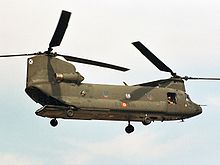 CH-47 Chinook helicopter.
CH-47 Chinook helicopter.
- 17 Boeing CH-47 Chinook - heavy transport (Spanish denomination HT-17)
- 16 Eurocopter AS 332 Super Puma - transport helicopter (Spanish denomination HT-21 UC)
- 14 Eurocopter AS 532
- 50 Eurocopter EC 135
- 31 UH-1 Iroquois
- 6 UH-1N Twin Huey To be transferred to the Spanish Navy
- 28 MBB Bo 105 To be sold to Uruguay
- 6 Eurocopter Tiger 24 planned
- 50 NHI NH90 planned
Unmanned aerial vehicles
- 4 Siva UAV
- 4 IAI Searcher MK II J
- 27 RQ-11 Raven
- EADS Barracuda (German - Spanish Joint Venture. Prototype stage)
See also
- NATO
- FAMET
- Spanish legion
- Regulares
References
- Instruction no. 59/2005, of 4 April 2005, from the Chief of the Army Staff on Army Organisation and Function Regulations, published in B.O.D. NO. 80 of 26 April 2005
- Lehardy, Diego, Spanish Army in a difficult phase of its transformation, RID magazine, July 1991.
External links and further reading
- Home page of the Spanish Land Army (English)
- Recruitment page (Spanish)
- The Spanish Military Forum
Ejército de tierra (Army) · Armada Española (Navy) · Ejército del Aire (Air Force)
Unidad Militar de Emergencias · Guardia Real (Royal Guard) · Guardia CivilArmies (land forces) in Europe Sovereign
states- Albania
- Andorra
- Armenia
- Austria
- Azerbaijan
- Belarus
- Belgium
- Bosnia and Herzegovina
- Bulgaria
- Croatia
- Cyprus
- Czech Republic
- Denmark
- Estonia
- Finland
- France
- Georgia
- Germany
- Greece
- Hungary
- Iceland
- Ireland
- Italy
- Kazakhstan
- Latvia
- Liechtenstein
- Lithuania
- Luxembourg
- Macedonia
- Malta
- Moldova
- Monaco
- Montenegro
- Netherlands
- Norway
- Poland
- Portugal
- Romania
- Russia
- San Marino
- Serbia
- Slovakia
- Slovenia
- Spain
- Sweden
- Switzerland
- Turkey
- Ukraine
- United Kingdom
- Vatican City
States with limited
recognition- Abkhazia
- Kosovo
- Nagorno-Karabakh Republic
- Northern Cyprus
- South Ossetia
- Transnistria
Categories:- Spanish Army
- Military of Spain
Wikimedia Foundation. 2010.

